One in two employers takes only between 1 and 5 minutes to review a CV or a resume, while one-third admits to paying attention only to some of the CV and resume sections. This is only some of the interesting data we have gathered in our case study about CV mistakes.
In this article, we have listed some of the more and less obvious common mistakes in a resume that you need to avoid if you don’t want it to end up in the trash. To help us get insight into the minds of employers, we conducted a short survey* where they were honest with which mistakes leave a bad impression on them and which could cost you the chance to be invited for an interview.
KEY SURVEY FINDINGS
- 75% of employers would reject a CV/resume because of bad grammar and typos
- 93% of employers want to see your phone number in the contact section
- 61% of employers identify incorrect role order list as a mistake
- 57% of employers could reject a resume longer than 2 pages
- 43% of employers dislike not showing impacts and accomplishments
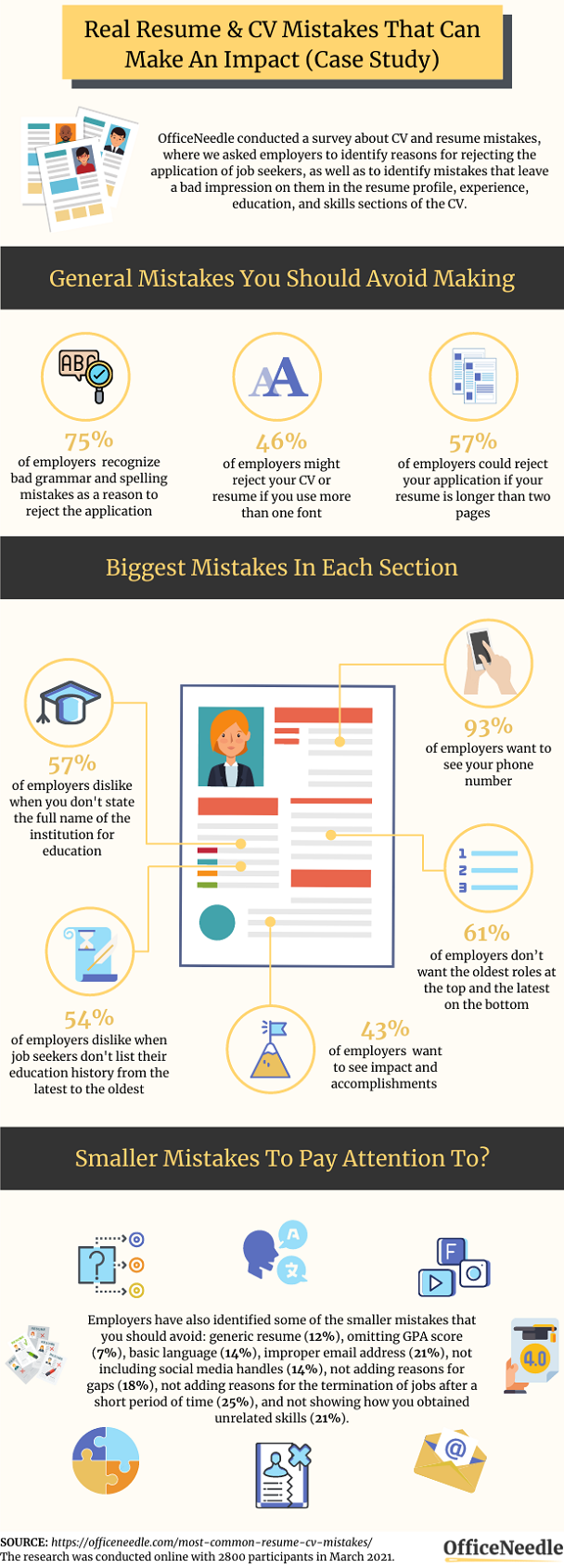

Resume vs. Curriculum Vitae (CV)
A resume is French for “summary”, while curriculum vitae is Latin for “course of life”.
While both are used to represent you and your qualifications when applying for a job, there are some key differences between the two.
A resume is usually shorter than a CV, and it focuses on your skills and qualifications for a certain industry position. Depending on how much experience you have, it should be around a page or two pages in length. A CV, on the other hand, focuses on your academic credentials and presents a lengthy history of your education, research and publishing experience, and more.
While CVs are used to apply for academic positions in research, as well as grants, and fellowships, a resume is used when applying for a position in the public sectors, industry, and more.
19 Mistakes In Resume & CV To Avoid If You Want To Get Hired
Once you start writing a CV or a resume, your main goal should be to get invited for an interview. For your application to stand out, you will have to write an immaculate CV to make a distinction between yourself and other candidates. There are some things to keep in mind and some mistakes to avoid here. After all, you should want to research the company where you are applying and tailor your CV to the job position for it to work. This way, you can take your career development in the right direction! So, let’s start!
General Mistakes In Resumes & CVs
BIG IMPACT MISTAKES
1. Not Tailoring The CV Or Resume
Sending a generic CV or resume without any customization for the specific job opening you are applying to? I know, it even sounds like a buzz kill. The truth is, around half of employers (46.4%) won’t even bother to take a second look at your CV or resume if you haven’t tailored it to show that you have the required skills and knowledge.


To help you highlight that you have the targeted skills, look for the job advert where you should usually be able to find what the company is looking for in an employee. After you do the research, you should be able to address the desired skills in the CV or resume if you have them.
2. Grammar & Spelling Mistakes
To prove you are the right choice for a certain position, you will probably need to show your strong skills in written communication. That means that there is no space for error in your final CV or resume document. Moreover, over 75% of employers recognize bad grammar and spelling mistakes as a reason to reject the application as it leaves a bad impression on them.


Make sure to proofread it, so that you don’t send your CV or resume with some of the common typing mistakes like “untill”, “acheive”, “seperate”, and so on. Also, bad grammar won’t be tolerated so make sure to really think through and read your CV or resume out loud to correct any mistakes before sending it.
3. Making The Resume Too Long
You might think that making your resume long is a good idea. However, most hiring managers won’t spend that much time on just one resume. That is why you should aim to list all of your information in one to two pages. A quarter (25%) of employers take under one minute to review the CV or resume, while one in two employers (57.1%) could reject your application if your resume is longer than two pages.
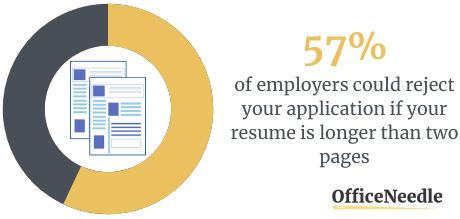

This will also depend on how much experience you have. In case you are an experienced jobseeker with over 5 years of job history, your CV or resume can be longer than one page. Otherwise, aim to keep it a one-pager.
4. Poor Layout & Design
Besides making sure that your CV or resume is not too long, also pay attention to how you layout the pages and design them for easy reading. Here it is important to make a distinction between different sections of the CV or resume and make sure that you don’t use a lot of fonts on the same page.
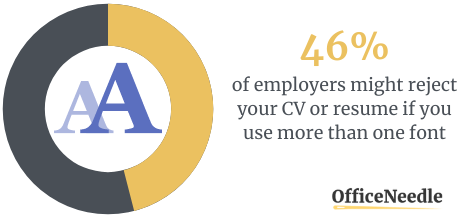

Around 46% of employers might reject your CV or resume if you use more than one font. Meanwhile, over one in three (32.1%) employers think the poor layout leaves a bad impression on them that could lead to rejection of the application. Also, make sure to address the keyword for the job position in your resume or Cv, but don’t use it excessively. To prevent this, read the sentences out loud and then you can make sure the CV or the resume is easy to read and understand.
SMALL IMPACT MISTAKES
5. Using Basic Language
In a CV or a resume, we want and should sound like professionals, so there is no space for slang words and basic language. You should aim to come off as a professional by using the right terminology. Around 14% of employers dislike seeing basic language as it leaves a bad impression on them.
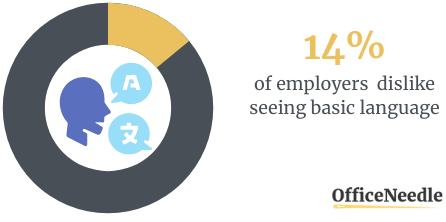

Depending on the industry you are looking to work in, you can achieve a level of professionalism by using jargon specific to it. For example, avoid basic sentences like “Writing articles to attract audiences” and instead phrase it like this “Writing about relevant gardening topics to provide timely information for seeking audiences” with more specific terminology.
6. Unrelated Resume Or CV
When applying for a job, you must make sure that your CV or resume is related to the job opening. Sending a generic CV won’t help as it most probably won’t catch the eye of the recruiter or employer. In other words, you won’t attract much feedback in case you send a unified CV to apply for many different jobs.
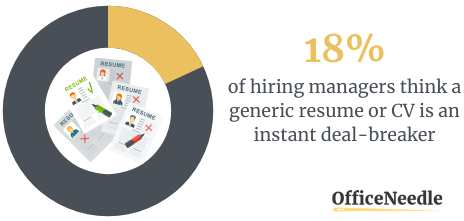

Most people will be applying for a bunch of different jobs at once, but it won’t be effective if you don’t relate the contents of your resume to the specific role you are applying for. According to this research, 18% of hiring managers think a generic resume or CV is an instant deal-breaker.
Below you can also check out which other general mistakes employers have identified so that you can avoid making them:
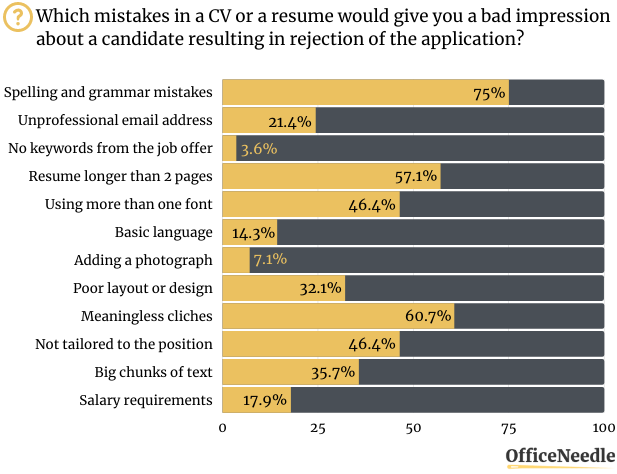

Mistakes In CV & Resume Profile
BIG IMPACT MISTAKE
7. Incorrect Contact Information
Okay, this sounds silly. However, it is possible that you put in your number wrong or that you have not updated it since you changed your email or phone number last time.
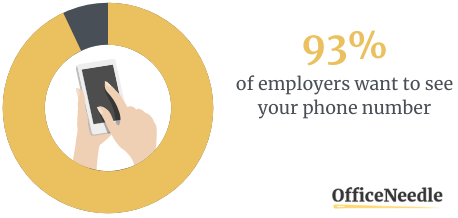

To ensure employers and recruiters can get a hold of you easily, make sure that the contact information you are providing them with is correct and up-to-date. Over nine in ten employers (92.9%) want to see your phone number in the contact section.
SMALL IMPACT MISTAKE
8. Adding Social Media Handles
While it is not a wise idea to include all of your social media handles in your resume or CV, most resume writers think it wrong to omit LinkedIn. If your social media profiles are mainly used for private reasons, then there is no point in giving your potential employer to take a look at them.
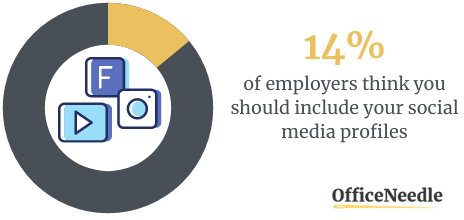

However, some employers practice looking up their candidates online. The first social media they think to use is LinkedIn. This social media is oriented to employment and business. On the other hand, only 14% of employers who participated in our survey think you should include your social media along with your personal and contact information.
9. Unprofessional Email Addresses
Some job seekers don’t think of how ridiculous they could sound to an employer if they put silly names and suspicious number combinations in their email addresses. Around 21% of employers could reject your application otherwise.
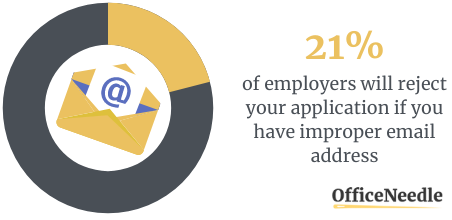

As you want to appear professional and credible, create an email address that includes your first and last name, or a combination of those with initials and numbers. Any email address that makes you feel embarrassed won’t cut it.
Wondering what else you should or should not put on your CV and resume profile? Take a look at what the employers who participated in the survey think:
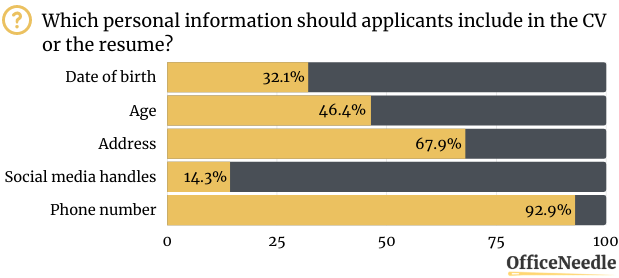

Mistakes In The Experience Section
BIG IMPACT MISTAKES
10. Incorrect Role Order List
It is very important to put your latest job position at the top of the role list. You will leave a bad impression on around 61% of employers if you put the oldest roles at the top and the latest at the bottom of the experience section. With the latest roles at the top, the employer can assess your latest skills and knowledge easily.
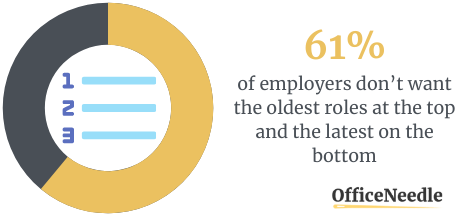

Once you’ve covered your latest role, you can start making your way down to the first role you had. Moreover, this also makes sense as you have probably progressed since your first. Your employer won’t be that interested in what you did all that time ago at your first job.
11. Too Much Or Not Enough Detail For Roles
In case you are a job seeker with experience in more than 2 roles so far, read this. Besides ordering them from the latest down to the first role at your first job, there is something else to keep in mind. Make sure to highlight your latest role by giving it the most detail in terms of what your responsibilities and tasks were.
For your latest job role and any relating positions to the one you are applying for, try to set the scene and imply how your work could impact your employer.
SMALL IMPACT MISTAKE
12. Not Explaining The Gaps In The CV Or Resume
For employers, it is important to see that you progress over time and that you have some kind of continuity to your career. However, it is possible that there are some gaps in your CV or resume where you didn’t get up to much in terms of your working experience. Under a fifth of employers (17.9%) will want to see reasons for gaps in your resume.
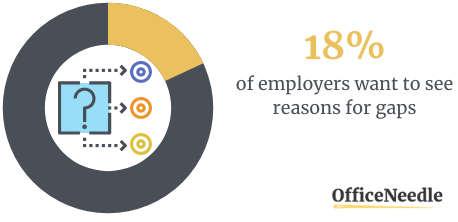

It is possible that you were sick, traveling the world, focusing on family time, and so on. By showing this on your CV or resume, you can notify your employer that you have been productive even when not working or that something out of your control prevented you from working.
13. Justifying Leaving The Job
A successful CV or resume will help you sell your talents to a potential employer. On the other hand, making a mistake such as showing reason as to why you left any job on your resume can undermine that. A hiring manager doesn’t have to know why you left any job.
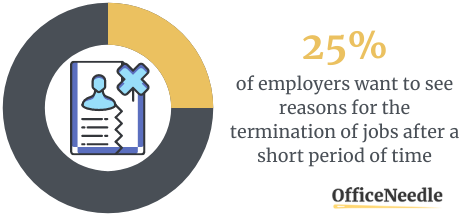

According to our study, only a quarter of employers (25%) want to see reasons for the termination of jobs after a short period of time. However, you can mention why you would leave your current job to join a new employer in the cover letter. Adding it to your CV or resume will simply make you lose precious space on the page.
Have doubts about other information you want to include in the experience section? Check out which other mistakes our survey participants identified as mistakes that leave a bad impression on them.
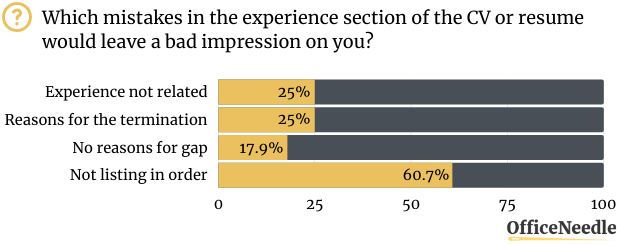

Mistakes In The Education Section
BIG IMPACT MISTAKE
14. Incorrect Order Of Education History
Similar to ordering experience the wrong way, you could leave a bad impression on employers by doing the same for your education history. Around 54% of employers dislike when job seekers don’t list their education history from the latest to the oldest. That is why you should always list it from your latest education information down to the oldest. It is easier to see what is your latest status on education that way.
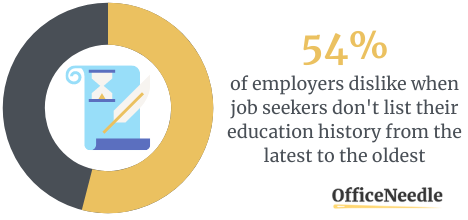

15. Using Initials For University Or College
When you list colleges and universities you have attended, make sure to write down their full names. For example, instead of stating you attended UCLA, change it to the University of California, Los Angeles.
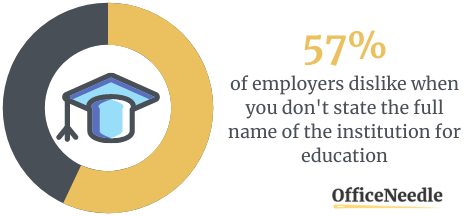

More than one in two employers who took our survey (57.1%) say that not stating the full name of the institution you attended for education leaves a bad impression on them.
SMALL IMPACT MISTAKE
16. Including Your GPA
In case you have doubts about whether you should include your Grade Point Average, you probably shouldn’t include it. Some job seekers like to include it, especially if they had a high GPA score during education.
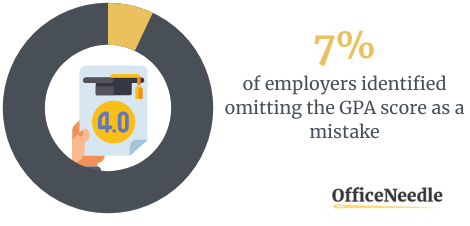

For anyone who is not too proud of their GPA score, do not fret. Simply don’t include it in your resume. Only 7% of the employers who took our survey identified omitting the GPA score as a mistake.
Unsure about what else you should include or avoid in the education section? Take a look at what else employers have identified as major or minor mistakes:


Mistakes In The Skills Section
BIG IMPACT MISTAKES
17. Showing Skills Without Measurements
Once you start on the skills section of the CV or resume, the idea is not to simply list them and move on. What you should do instead is demonstrate your value by adding real-life measurements to the equation. Think of the following:
a. showing experience by saying you are “a 5-year sales representative” or
b. letting your potential employer know you are a “certified lifeguard”.
18. Not Showing Impact & Accomplishments
Everyone knows to show their skills and abilities in the resume or CV to attract the employer to invite you for an interview. However, not many people think to show their impact to give the employer an idea of how you could contribute to their business. Not showing impact and accomplishments leaves a bad impression on around 43% of employers.
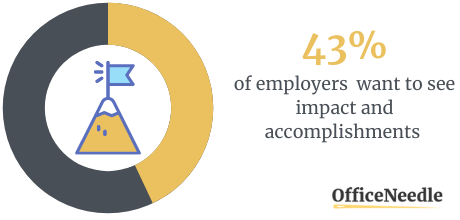

You should aim to show your impact by stating what the result of your skills is. Quantifying impact can be done by providing numbers and figures when talking about your tasks and skills wherever possible. For example, you should not simply list the duties of your role, but go on to show what you accomplished by doing them.
SMALL IMPACT MISTAKE
19. Lies & Unproven Claims
Job seekers tend to add more to the CV or resume by stating some facts that are not always entirely true. Just remember Joey from Friends. Awkward, right? Painting an unrealistic picture won’t do you any good in the long run. Around one-fifth (21.4%) of employers want to see how you obtained skills that are not related to your education or working experience.
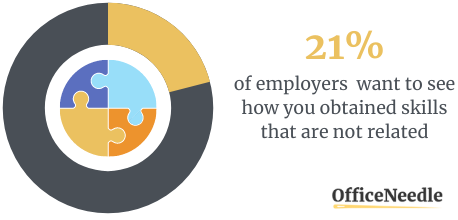

For example, if you state you have mad Photoshop skills, chances are your potential employer will try to test it and you will end up looking like a liar. Most employers won’t have the time to prove if you really worked at that specific job, but it would still be best not to lie about anything that could be so easy to check.
Doubting whether you should have included some other information in the skills section? Learn about mistakes that leave a bad impression here:
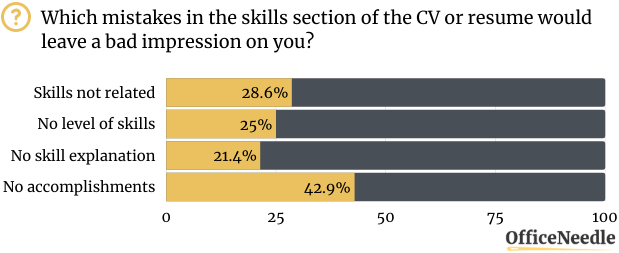

What Can You Do?
As we have stated above, 46% of employers could reject a CV or a resume using more than just one font. If your current CV or resume has more than one font, change it to just one font that is easily readable. Also, customize the skills section to show impacts and accomplishments, as almost one in two employers dislike when you fail to show this. Now that we have listed big and small impact mistakes that you should avoid making in different sections of your resume or CV, it is your turn to do the rest. Maybe all it is going to take is fixing a few things to finally get that interview and omit rejections in the initial stages of applying for a job. Let us know how you get on in the comments down below!
*The research was conducted online with 2800 participants around the world in March 2021.



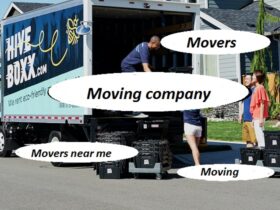











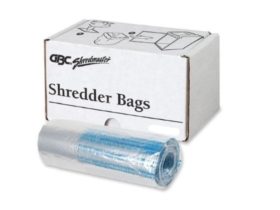


















Find Us on Socials